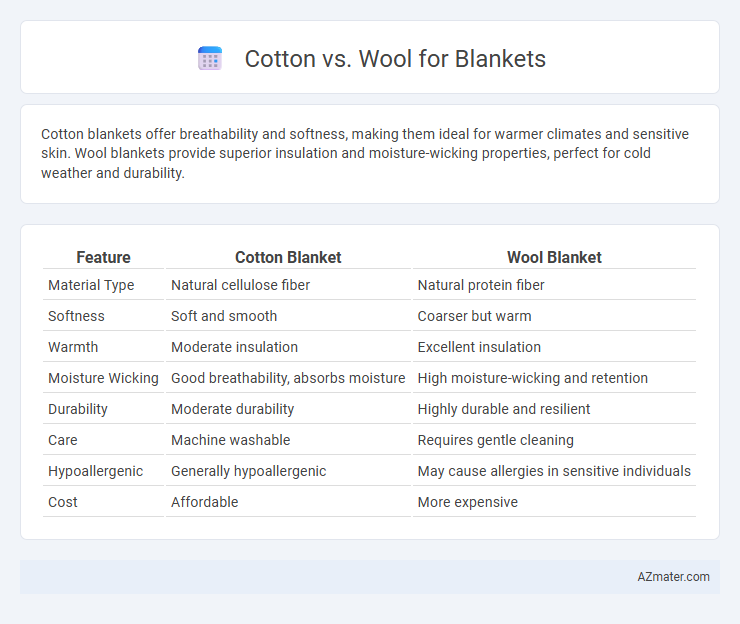Cotton blankets offer breathability and softness, making them ideal for warmer climates and sensitive skin. Wool blankets provide superior insulation and moisture-wicking properties, perfect for cold weather and durability.
Table of Comparison
| Feature | Cotton Blanket | Wool Blanket |
|---|---|---|
| Material Type | Natural cellulose fiber | Natural protein fiber |
| Softness | Soft and smooth | Coarser but warm |
| Warmth | Moderate insulation | Excellent insulation |
| Moisture Wicking | Good breathability, absorbs moisture | High moisture-wicking and retention |
| Durability | Moderate durability | Highly durable and resilient |
| Care | Machine washable | Requires gentle cleaning |
| Hypoallergenic | Generally hypoallergenic | May cause allergies in sensitive individuals |
| Cost | Affordable | More expensive |
Introduction: Cotton vs Wool Blankets
Cotton blankets offer lightweight breathability, making them ideal for warm climates and sensitive skin due to their hypoallergenic properties. Wool blankets provide superior insulation and moisture-wicking capabilities, perfect for cold environments and sleepers seeking natural warmth. Comparing thermal regulation, durability, and comfort highlights key differences that influence the choice between cotton and wool blankets.
Material Overview: Understanding Cotton and Wool
Cotton blankets are made from soft, breathable fibers derived from the cotton plant, offering excellent moisture absorption and hypoallergenic properties ideal for sensitive skin. Wool blankets, sourced from sheep fleece, provide exceptional warmth through natural insulation and moisture-wicking abilities while remaining durable and resistant to odors. Both materials present distinct advantages, with cotton excelling in breathability and softness, and wool delivering superior heat retention and resilience.
Warmth and Insulation Comparison
Wool blankets provide superior warmth and insulation compared to cotton due to natural crimped fibers that trap heat efficiently, making them ideal for cold climates. Cotton blankets offer moderate insulation but are more breathable and better suited for mild temperatures or layering, as they allow moisture to escape and reduce heat retention. Wool's ability to retain warmth even when damp enhances its insulating properties, outperforming cotton in maintaining consistent body heat during colder conditions.
Breathability and Moisture-Wicking Properties
Cotton blankets offer excellent breathability due to their natural fiber structure, allowing air to circulate and helping regulate body temperature during sleep. Wool blankets excel in moisture-wicking properties, efficiently absorbing and releasing moisture to keep users dry and comfortable in varying climates. Both materials provide unique benefits, with cotton ideal for warm, humid environments and wool preferred for cooler, damp conditions.
Comfort and Softness Factors
Cotton blankets offer exceptional breathability and softness, making them ideal for sensitive skin and warmer climates due to their natural fibers that wick moisture efficiently. Wool blankets provide superior insulation and a cozy feel, with their ability to regulate temperature by trapping heat, though they can sometimes feel scratchy to those with delicate skin. Choosing between cotton and wool blankets depends on personal comfort preferences, with cotton excelling in softness and breathability while wool shines in warmth and durability.
Allergies and Skin Sensitivity
Cotton blankets are hypoallergenic and breathable, making them ideal for individuals with sensitive skin or allergies prone to irritation from synthetic fibers or animal hair. Wool blankets, while warm and naturally moisture-wicking, can sometimes trigger allergic reactions due to lanolin content, which may cause itchiness or discomfort in sensitive users. Choosing cotton over wool reduces the risk of skin irritation and allergic responses, promoting better comfort for those with dermatological sensitivities.
Durability and Longevity
Wool blankets are renowned for their exceptional durability and natural resilience, often lasting for decades without significant wear due to their fiber strength and moisture-wicking properties. Cotton blankets, while soft and breathable, tend to have a shorter lifespan as their fibers are more prone to wear and tear over time, especially with frequent washing. Choosing wool is ideal for long-term use and heavy-duty warmth, whereas cotton suits seasonal use with a softer feel but less longevity.
Care and Maintenance Requirements
Cotton blankets require regular washing with mild detergents and can be machine dried on low heat to maintain softness and prevent shrinkage. Wool blankets demand more delicate care, including hand washing or dry cleaning, and should be air-dried flat to avoid felting and distortion. Proper care ensures longevity, with wool needing special attention to moisture and agitation compared to the more durable and easy-to-maintain cotton.
Eco-Friendliness and Sustainability
Cotton blankets, especially organic cotton, are highly eco-friendly due to their natural biodegradability and lower energy requirements during production compared to synthetic fibers. Wool blankets offer exceptional sustainability by being a renewable resource with biodegradability and natural insulation properties, reducing the need for additional heating. Both materials support sustainable practices, but wool's durability and ability to be recycled into new products make it a superior eco-conscious choice for long-term use.
Best Choice: Cotton or Wool Blanket?
Cotton blankets offer breathable, lightweight comfort ideal for warmer climates and sensitive skin, while wool blankets provide superior insulation, moisture-wicking, and durability suited for cold weather. Choosing the best blanket depends on personal preferences for temperature regulation, allergy considerations, and care requirements, as cotton is machine-washable and less prone to allergens, whereas wool requires delicate handling but excels in warmth retention. For a versatile and allergy-friendly option, cotton is preferred, whereas wool is the best choice for maximum warmth and natural temperature control.

Infographic: Cotton vs Wool for Blanket
 azmater.com
azmater.com